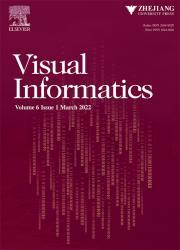EmotionLens:通过情感词云对文学作品中复杂的情感空间进行交互式视觉探索
IF 3.8
3区 计算机科学
Q2 COMPUTER SCIENCE, INFORMATION SYSTEMS
引用次数: 0
摘要
情感(如价、情)是文学(如诗、文)的重要因素,在描绘历史人物的生活、知识和欣赏文学作品的美学方面具有丰富的价值。目前,数字人文学科和计算文学将数据统计广泛应用于情感分析,但缺乏可视化分析来进行有效的探索。为了填补这一空白,我们提出了一种以用户为中心的方法,该方法集成了先进的机器学习模型和直观的可视化,用于文献中的情感分析。我们做出了三个主要贡献。首先,我们整合了一个新的情感数据集,该数据集包含不同时期、不同文学类型和不同语言背景的文学作品,并添加了细粒度的价态和唤醒标签。接下来,我们设计了一个名为EmotionLens的交互式视觉分析系统,该系统允许用户对文学情感进行多粒度(例如,个人,群体,社会)和多方面(例如,分布,时间顺序,相关性)分析,支持数字人文学科的探索性和验证性方法。具体来说,我们引入了一种新的情感词云,增强了词的权重、位置和颜色,以促进从情感角度分析文学文本。为了验证EmotionLens的可用性和有效性,我们提供了两个连续的案例研究,两个用户研究,并采访了来自不同领域的专家。我们的研究结果表明,EmotionLens在文学文本、情感和各种其他属性之间架起了桥梁,能够在海量数据中高效地发现知识,并有助于提出和验证文学中特定领域的假设。本文章由计算机程序翻译,如有差异,请以英文原文为准。
EmotionLens: Interactive visual exploration of the circumplex emotion space in literary works via affective word clouds
Emotion (e.g., valence and arousal) is an important factor in literature (e.g., poetry and prose), and has rich values for plotting the life and knowledge of historical figures and appreciating the aesthetics of literary works. Currently, digital humanities and computational literature apply data statistics extensively in emotion analysis but lack visual analytics for efficient exploration. To fill the gap, we propose a user-centric approach that integrates advanced machine learning models and intuitive visualization for emotion analysis in literature. We make three main contributions. First, we consolidate a new emotion dataset of literary works in different periods, literary genres, and language contexts, augmented with fine-grained valence and arousal labels. Next, we design an interactive visual analytic system named EmotionLens, which allows users to perform multi-granularity (e.g., individual, group, society) and multi-faceted (e.g., distribution, chronology, correlation) analyses of literary emotions, supporting both exploratory and confirmatory approaches in digital humanities. Specifically, we introduce a novel affective word cloud with augmented word weight, position, and color, to facilitate literary text analysis from an emotional perspective. To validate the usability and effectiveness of EmotionLens, we provide two consecutive case studies, two user studies, and interviews with experts from different domains. Our results show that EmotionLens bridges literary text, emotion, and various other attributes, enables efficient knowledge discovery in massive data, and facilitates raising and validating domain-specific hypotheses in literature.
求助全文
通过发布文献求助,成功后即可免费获取论文全文。
去求助
来源期刊

Visual Informatics
Computer Science-Computer Graphics and Computer-Aided Design
CiteScore
6.70
自引率
3.30%
发文量
33
审稿时长
79 days
 求助内容:
求助内容: 应助结果提醒方式:
应助结果提醒方式:


